Oswald of Northumbria › Norse Mythology » Ancient origins
Articles and Definitions › Contents
- Oswald of Northumbria › Who Was
- Norse Mythology › Antique Origins
Ancient civilizations › Historical and archaeological sites
Oswald of Northumbria › Who Was
Definition and Origins
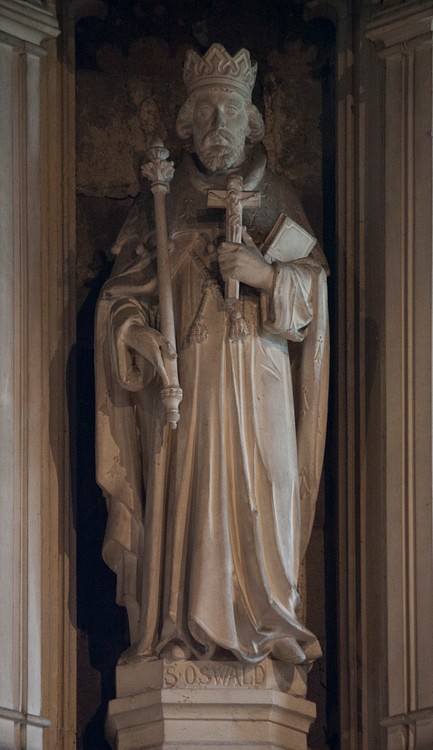
Oswald of Northumbria (c. 604 - c. 642 CE) was a 7th-century Anglo- Saxon king and saint. He came to power in Northumbria c. 633 or 634 CE following his victory over Cadwallon ap Cadfan, King of Gwynedd. Oswald ruled over the Northumbrian kingdoms of Bernicia and Deira but also exerted significant authority over parts of modern-day England, Wales, and Scotland. Oswald's reign is praised by the Northumbrian historian Bede, writing in the 8th century CE; he is one of the heroes of Bede's influential work, the Historia Ecclesiastica Gentis Anglorum ( Ecclesiastical History of the English People ).Oswald vigorously spread Christianity in his kingdom and beyond. C. 642 CE, he was killed at the Battle of Maserfield against the Mercian king Penda. Following his death, Oswald was revered as a saint and martyr. His relics were venerated and a cult formed in England and on the Continent which thrived in the Middle Ages.
BACKGROUND, EARLY LIFE, & EXILE
During Oswald's life, the term Northumbria was not yet in use. The region that would later generations call Northumbria was then roughly composed of two separate kingdoms, Deira and Bernicia, which lay north of the River Humber. The term Northumbria probably came into use in the early 8th century CE to describe the lands north of the Humber. The kingdom of Deira extended roughly from the Humber River north to the Tees River. Bernicia lay to the north of Deira and stretched from the Tees River to the Firth of Forth. The royal houses of the two respective kingdoms were often referred to as Angles in the ancient sources, as opposed to Saxons who seem to have ruled many of the kingdoms to the south. The two families were enemies, constantly at war with each other from the end of the 6th century CE through much of the 7th century CE.
Oswald was one of seven known children of Aethelfrith of Bernicia and Acha, with his birth generally dated to c. 604 CE. His older brother Eanfrith seems to have been Aethelfrith's child from another union. Very little is known about these children other than Eanfrith, Oswald, and Oswiu. In 604 Aethelfrith became king of Deira as well as Bernicia, probably through conquest.He married Acha, sister of Edwin of Deira and daughter of the deposed king, uniting the two rival kingdoms under his own rule.Edwin himself fled south to escape Aethelfrith. For some years, Edwin wandered in exile while Aethelfrith designed to have him killed. Eventually, Edwin was welcomed at the court of Raedwald of East Anglia. Raedwald refused Aethelfrith's request to have Edwin killed, instead, he turned on Aethelfrith, defeating and killing him in battle near the River Idle c. 616 CE.
Aethelfrith's death forced his sons to flee north into exile as Edwin had done years earlier. Oswald spent his exile in the Gaelic kingdom of Dal Riata, which covered much of western Scotland and part of Ireland. During his exile, Oswald converted to Christianity though his father had been a pagan.
BATTLE OF HEAVENFIELD & KINGSHIP
In October 633 CE, Edwin met the combined armies of Penda of Mercia and Cadwallon of Gwynedd at the Battle of Hatfield Chase. The battle was a resounding defeat for Edwin's forces; Edwin was killed and much of his army destroyed. The kingdoms of Deira and Bernicia, united under Edwin's rule, were once again split between the two respective royal houses.Oswald's brother Eanfrith returned from exile to rule Bernicia while Edwin's cousin Osric ruled Deira. Penda seems to have returned to Mercia, but Cadwallon continued to attack the lands of the two Northumbrian kingdoms.
OSWALD'S REIGN IS PRAISED BY THE NORTHUMBRIAN HISTORIAN BEDE, WRITING IN THE 8TH CENTURY CE; HE IS ONE OF THE HEROES OF BEDE'S INFLUENTIAL WORK, THE HISTORIA ECCLESIASTICA GENTIS ANGLORUM.
According to Bede, Osric and Eanfrith only ruled their respective kingdoms for about one year (c. 632 or 633 CE). Bede writes that both Eanfrith and Osric shamefully abandoned the Christian faith for their ancestral gods. Bede blames this apostasy for their swift downfalls. Osric seems to have besieged Cadwallon in an unnamed fortress or town, but Cadwallon attacked and killed Osric and scattered his forces. At some point later in the same year, Eanfrith went to negotiate a peace with Cadwallon, bringing with him only twelve warriors, and Cadwallon had them all killed.
Following Eanfrith's death, Oswald returned from exile and claimed the throne of Bernicia. Bede writes that Oswald returned to Bernicia with only a small army. It is possible that he was supported in his bid for power by Scottish and Pictish allies as well as his own retainers. Oswald met Cadwallon's forces at a place called Heavenfield, near Hexham. Bede writes that Cadwallon's force was much larger, but that Oswald was aided by God. On the night before the battle, Oswald erected a large wooden cross and he and his troops prayed to the Christian God for victory. At least one account mentions a vision of Saint Columba appearing to Oswald, assuring him that he would be victorious.
The Battle of Heavenfield took place the next day, and Oswald's forces won a crushing victory. Cadwallon himself was killed and his supporters thoroughly routed. Oswald's counsellors all agreed to be baptised following the battle, and Oswald took control of both Bernicia and Deira, reuniting the Northumbrian kingdoms. Bede claims that Oswald held imperium over virtually all of the other Anglo-Saxon kingdoms during his reign, as well exerting influence over neighbouring Celtic lands. Oswald is referred to as Bretwalda in the Anglo-Saxon Chronicle. The term Bretwalda ( brytanwalda or bretenwealda ) refers to Oswald's status as de facto overlord of Britain and is analogous to Bede's concept of imperium.
OSWALD & CHRISTIANITY
Oswald fully embraced the Christian faith as few other northern Anglo-Saxon kings had before him. Bede considers Oswald the saintliest of all the kings he examines in the Historia Ecclesiastica. His father died a pagan, and even Edwin had only been baptised after becoming king. Meanwhile, Oswald was baptised long before coming into power. As a result of his time spent in Dal Riata and beyond, Oswald allied himself with the Celtic Christian faith centred around the monastery of Iona. This brand of Christianity stood in marked contrast with the Rome -oriented community centred in Canterbury to the south, founded by Saint Augustine the Lesser in 597 CE. The rivalry between these factions would come to a head, well after Oswald's death, at the Synod of Whitby in 664 CE.

St Oswald & St Aidan
Oswald requested a bishop from Iona rather than from Canterbury. At first, the monastery sent a man named Corman who proved to be too austere and rigid. Thus, he was recalled, and in his place the community of Iona sent Aidan. Upon his arrival in Northumbria, the seat of Aidan's diocese was founded on the island of Lindisfarne, which lay not far from the royal seat of Bamburgh. While Bede was critical of certain aspects of the Celtic Christian tradition (he was more closely allied with Rome than the northern church of Oswald's day), he greatly admired Aidan. Bede writes that Oswald went so far as to translate for Aidan during many of his sermons, as Aidan could not yet speak English.
Bede also writes that Oswald was a friend to the poor. He also vigorously promoted the Christian faith beyond his own borders.He stood as godfather to the West Saxon king Cynegils (rc 611-642 CE) upon his baptism in Dorchester and also married Cynegils' daughter. This speaks of Oswald's status as overlord over the other Anglo-Saxon kingdoms at this point in his reign.
DEATH
Oswald was killed at the Battle of Maserfield ( Maserfelth ) on August 5, c. 641 or 642 CE. Bede writes that he had reigned for eight years and was 38 years old at the time of his death. Though details of the conflict are scant, the battle was fought between Oswald's forces and the army of Penda of Mercia, who had also taken part in the victory over Edwin roughly nine years earlier. Bede writes that upon his death Oswald prayed for the souls of his warriors. After the battle, the pagan Penda had Oswald's head and hands cut off and displayed as trophies. This has been interpreted by some as a possible offering to the pagan god Woden.
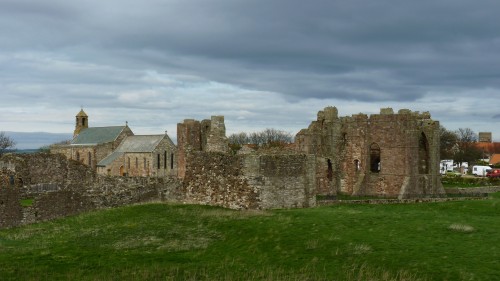
Lindisfarne
The location of the battle is not precisely known but is traditionally identified with modern-day Oswestry. At the time of Oswald's death, Oswestry would have been located in the territory of the Welsh kingdom of Powys. This suggests that Oswald was leading an attack well beyond his borders and thus conflicts with Bede's account of a saintly king. It also suggests that Welsh troops may have supported Penda against Oswald. Bede writes that Oswald was fighting a just war at the time of his death, but he is virtually silent on the causes of the conflict.
Oswald's death shattered Northumbrian supremacy just as Edwin's death had nine years before. Bernicia and Deira once again split between the two traditional royal houses, with Oswald's younger brother Oswiu ascending to the Bernician throne.Penda and the Mercians would exert considerable authority over the neighbouring kingdoms for much of the next decade. It was not until c. 655 CE that Oswiu would finally defeat and kill Penda at the Battle of the Winwaed.
VENERATION
Oswald's sainthood followed soon after his death at Maserfield. Though Bede took pains to depict Oswald as holy in life, he and later chroniclers recount a catalogue of miracles associated with his martyrdom. Soil from the spot where Oswald was killed was said to have had miraculous healing properties. According to the 12th-century monk Reginald of Durham, Oswald's right arm was carried off by a bird and dropped near a tree. A spring formed where Oswald's arm landed, and both the spring and the tree exhibited healing powers. Splinters from the cross at Heavenfield were also said to have displayed healing powers. There has been some scholarly debate over whether the miraculous properties of Oswald's relics reflect pagan Germanic notions of kingship.
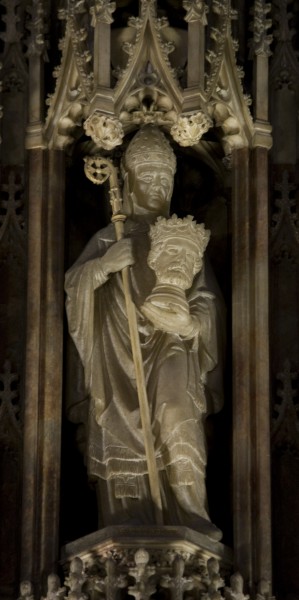
St Cuthbert with St Oswald's head
Oswald's relics were moved several times. According to Bede, Oswald's body was brought to Bardney Abbey in Lindsey where the monks initially refused to take the body in, as Oswald had been an enemy of the Kingdom of Lindsey during his lifetime.However, a miraculous beam of light encompassing the body validated Oswald's status as a saint and changed the monks' minds. Oswald's head is believed to be interred in Durham Cathedral, though there are several other churches who claim to possess his head in England and on the Continent. His right arm was said to have remained undecayed after his death and was eventually enshrined in Peterborough Abbey. Oswald's Feast Day is celebrated on August 5.
Oswald's status as a saintly Christian king loomed large in the imaginations of later generations. Not only were his efforts in life essential for the spread of Christianity in Northumbria and throughout England but he served as a model of Christian kingship for centuries to come. For Bede, Oswald was the epitome of proper kingship in the Historia Ecclesiastica. The royal family of Wessex seems to have taken Oswald as a model as well in the late 9th and early 10th centuries CE. The royal house of Wessex took pains to acquire Oswald's relics for monasteries and churches they founded, and at least one of these churches, St. Oswald's Priory in Gloucester, was named after the king. Aethelstan (rc 924-927 CE) was an enthusiastic patron of Oswald's cult. How much of Oswald's legacy is due to his own actions or due to Bede's influential portrait is the subject of debate. In either case, the figure of the saintly king martyred in battle against a pagan enemy proved to be a resilient symbol in later centuries when Christian English kings contended with heathen Viking invaders.
Norse Mythology › Antique Origins
Definition and Origins
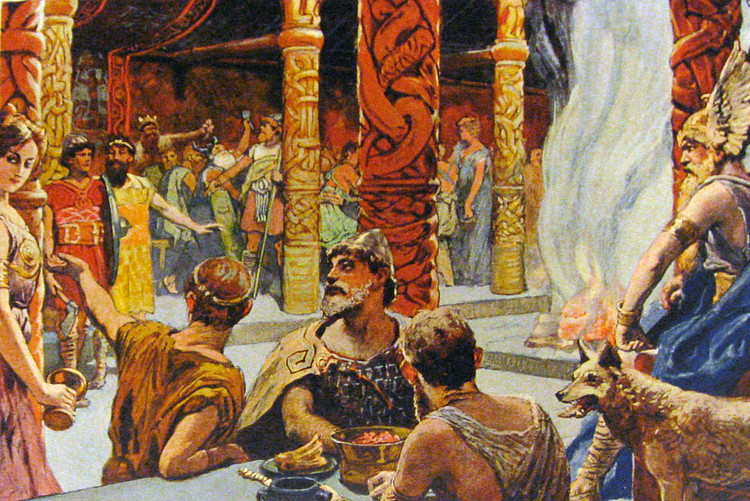
Norse mythology refers to the Scandinavian mythological framework that was upheld during and around the time of the Viking Age (c. 790- c. 1100 CE). Complete with a creation myth that has the first gods slaying a giant and turning his body parts into the world, various realms spread out beneath the World Tree Yggdrasil, and the eventual destruction of the known world in the Ragnarök, the Nordic mythological world is both complex and comprehensive. Its polytheistic pantheon, headed by the one-eyed Odin, contains a great number of different gods and goddesses who were venerated in customs integrated into the ancient Scandinavians' daily lives.
MAIN SOURCES
Peeling back the layers of history in order to form a properly detailed and accurate picture of the myths, beliefs, and customs as they actually were in the Viking Age is no mean feat, especially for an overwhelmingly oral society, as Scandinavia mostly was at the time. As such, we only have the "tips of the narrative icebergs" (Schjødt, 219) when it comes to the Norse gods.
On the one hand, we do have some genuine pre-Christian sources that preserve elements of Scandinavian mythology ; most importantly Eddic poetry (poetry from the Poetic Edda compiled in c. 1270 CE, but probably dating back to the pre-Christian era before the 10th century) and skaldic poetry (Viking Age, pre-Christian poetry mainly heard at courts by kings and their retinues), preserved in later Icelandic manuscripts. The Codex Regius found in the Poetic Edda contains an anonymous collection of older Eddic poems, including ten about gods and nineteen about heroes, and although some of these tell complete myths, most of them assume – unfortunately for us – that their audience was familiar with the mythical context. The same goes for skaldic poetry; with knowledge of the myths taken for granted, for us, using these sources to create a full picture of Norse mythology is a bit like filling in a rather difficult Sudoku puzzle.
THE INTEGRATED NATURE OF NORSE MYTHOLOGY IN THE VIKINGS ' DAILY LIVES IS BETRAYED BY THE WORD SÍÐ UR, MEANING 'CUSTOM' – THEIR CLOSEST CONCEPT TO RELIGION.
On the other hand, later medieval sources, such as Snorri Sturluson's Prose Edda (c. 1220 CE) and Saxo Grammaticus' Gesta Danorum composed a few decades earlier, reworked the changeable, enigmatic, but slightly tangled early Viking sources into much more structured accounts. Snorri's work is the main reason we have an inkling of Norse mythology and myths as a whole, but should also be read critically, as he wrote from a Christian context. However, the older Eddic and skaldic poems clearly do more justice to the dynamic and integrated role mythology actually played in Viking Age societies.
NORSE MYTHOLOGY IN VIKING SOCIETY
The integrated nature of the Norse mythological framework in daily life is betrayed by the word síður, meaning 'custom' – the closest concept the Old Norse language had to religion. Of course, what it was exactly the Vikings believed with regard to all these different Norse gods and the world they lived in is hard to pin down. However, archaeological evidence helps hint at personal devotion to specific gods people felt connected to, with accompanying customs and rituals being a standard part of everyday life.
In a broader sense, gods were also venerated and called upon by the whole community. Sites of potential cultic activity, for instance, may be identified by the appearance of the name of a god in place names, like in the case of Fröslunda ("the grove dedicated to the god Freyr "). Certain hotspots are hinted at by the sources, too. According to Adam of Bremen (who wrote his account - based on hearsay - c. 1070 CE) there was a great temple at Uppsala in Sweden which housed images of Thor, Odin, and Freyr, who were sacrificed to in times of famine or disease, war, or when weddings popped up, respectively. He relays how every nine years people got together there to let their long Viking tresses down during a great festival in which humans, horses and dogs were sacrificed, their bodies hanging from trees in the sacred grove. Although the archaeological record does not support the existence of an actual temple, the remains of other buildings, among which a large hall, dating to between the 3rd and 10th centuries, have been found.
There were, thus, various aspects to Norse mythology's place in Viking societies. As Anne-Sofie Gräslund words it, "Old Norse religion should not be regarded as a static phenomenon but as a dynamic religion that changed gradually over time and doubtless had many local variations" (56). Ancient Scandinavia was a world in which belief in divine powers abounded, and all of these had their own attributes and functions.
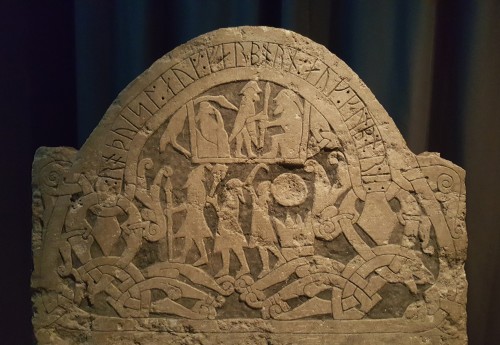
Viking Rune Stone (Sanda, Sweden)
The Norse worldview only gradually changed with the emerging influence of Christianity, which becomes apparent by the second half of the 11th century CE. Even then, because Vikings were polytheistic, they simply added Christ to their already rather lengthy list of gods, and different customs and beliefs were used side by side for a good while.
MYTHOLOGICAL WORLDVIEW
The Norse worldview as we can best distill from the various sources boils down to the following general idea. There were four phases: the process in which the world - and everything in it - was created; a dynamic phase in which time is started; the destruction of the world in the Ragnarök; and the arising of a new world from the sea.
ODIN, VILI, AND VÉ KILL YMIR & CREATE THE EARTH FROM HIS FLESH, THE SKY FROM HIS SKULL, MOUNTAINS FROM HIS BONES & THE SEA FROM HIS BLOOD.
According to Snorri, before anything else existed there were the opposing realms of icy Niflheim and fiery Muspelheim (which other sources simply call Muspell). Although seemingly safely separated by the empty void Ginnungagap, the cold and heat expanded to meet after all, resulting in Muspelheim's fire melting the ice, from which two assumingly dripping wet figures emerged: the (proto-)giant Ymir and the cow Audhumla. By licking the ice Audhumla uncovered Búri, forefather of the gods, whose son Borr teamed up with giant-daughter Bestla to sire the first gods, Odin, Vili, and Vé. These three then took advantage of Ymir's convenient size by killing him and using his remains to create the world; the earth from his flesh, the sky from his skull, mountains from his bones and the sea from his blood. The first human couple, Ask and Embla, were fashioned out of two trees or pieces of wood.
With humans popping up, a new phase begins; time has started, and all the gods and other creatures and their respective realms are off doing their own thing up until the Ragnarök. The World Tree Yggdrasil, the axis of time and space, stands in the gods' home realm of Asgard while its roots encompass all the other realms, including Midgard, where the humans reside, and the giants' abode Jotunheim. A dragon of death called Nidhogg chomps on said roots, all while the three fates (known as Norns) spin the fates of human lives at the tree's base. As the Prose Edda tells it:
Ash Yggdrasill › suffers anguish,More than men know of:The stag bites above; › on the side it rotteth,And Nídhöggr gnaws from below.(Gylfaginning 16).
As if a giant tree were not enough, the surrounding sea is inhabited by the Midgard Serpent (also known as Jörmungandr ), a monster who twists and coils itself around the world.
Eventually, these fairly peachy worldly conditions snowball into chaos and culminate in the Ragnarök, the 'final destiny of the gods', for which our main source is the 10th-century CE Völuspá saga. It starts with a terrible winter. The earth sinks into the sea, the wolf Fenrir (often referred to as the Fenris-wolf) breaks loose and devours the sun, and, as the icing on the already crumbling cake, mighty Yggdrasil shakes and the bridge Bifröst – the express-way between Asgard and Midgard – collapses.Understandably rattled, the gods hold an emergency council to prepare for battle against the powers of the Underworld, who are closing in. The Prose Edda heralds that:
Brothers shall strive › and slaughter each other;Own sisters' children › shall sin together;Ill days among men, › many a whoredom:An axe-age, a sword-age, › shields shall be cloven;A wind-age, a wolf-age, › ere the world totters.(Gylfaginning 51).
Odin fights Fenrir but falls, after which the god Vidarr avenges him, while Thor destroys the Midgard Serpent but succumbs to its poison. The gods and their foes die left, right, and centre, until the giant Surtr goes pyromaniac and kindles the world-fire that destroys everything.
Luckily, phoenix-style, the destruction is not the end. Following a cyclical concept of the world, a new world rises – not from the ashes, but from the sea. Only a handful of gods are still standing, but the new world will have a new generation of gods as well as humankind, to live happily ever after.
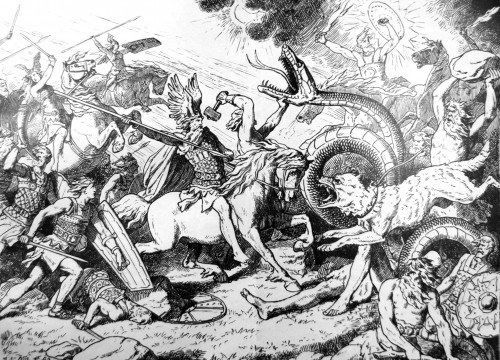 RAGNARöK
RAGNARöK

ÆSIR & VANIR
The gods themselves are boxed into two families. Firstly, there is the bigger Æsir family mostly connected with war and government, which was in practice also used as an umbrella term for the main gods in general. It includes notables such as Odin, Thor, Loki, Baldr, Hodr, Heimdall, and Týr.
Secondly, the smaller Vanir family contains fertility gods such as Njord, Freyr, and Freyja. Despite them all living in Asgard, they do not always see eye-to-eye - which, admittedly, is difficult considering Odin only has one eye, to begin with. In fact, they clash to the point of war (the 'Vanir wars'; or 'Æsir-Vanir Wars') but exchange hostages after making peace and fuse their families through marriage.
The contrast between the Æsir and the Vanir has been argued to stem from oppositions in Viking society, as the Vanir, with their focus on fertility, good harvests, and the climate, were popular in farming communities, while the Æsir were seen to advise kings, lords, and their warriors in matters of war and governance. As such, the peace made at the end of the Vanir wars might reflect the idea that society could only function through the combined powers of both social classes.
Finally, besides these two divine classes, there were also female deities known as Dísir, popular in private worship, Álfar(elves), Jǫtnar (giants), and Dvergar (dwarfs); enough to keep everyone busy, for sure. Norse mythology offers a very rich world to get lost in.
LICENSE:
Article based on information obtained from these sources:with permission from the Website Ancient History Encyclopedia
Content is available under License Creative Commons: Attribution-NonCommercial-ShareAlike 3.0 Unported. CC-BY-NC-SA License